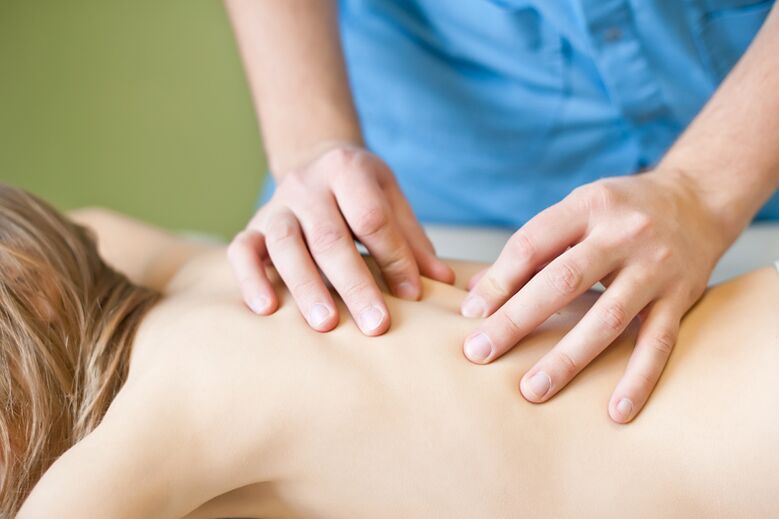
Osteochondrosis is a chronic disease manifested by degradation of the tissue structure of the vertebrae and intervertebral discs. There are three types of osteochondrosis, depending on which part of the spine the disease affects: lumbar, thoracic and cervical.
Symptoms of thoracic osteochondrosis of the spine
Thoracic osteochondrosis does not manifest itself immediately and in the initial stages can be almost invisible. Therefore, in order not to trigger the disease, you should not ignore its first symptoms and manifestations.
The main symptom is pain in the chest during movement, physical activity, and also when maintaining one body position for a long time. It can manifest itself as sharp, sudden and severe pain that makes movement and breathing difficult (dorsago) or as moderate, gradually increasing pain (dorsalgia).
Symptoms similar to dorsalgia do not always indicate the presence of problems with the spine, therefore, for an accurate diagnosis, it is advisable to undergo a comprehensive examination.
Symptoms may also include tension in the chest muscles, a feeling of constriction, a feeling of weakness in the limbs and partial or complete loss of sensation in the limbs.
Symptoms can also manifest themselves at the level of the autonomic system, in particular as follows:
- headache;
- sleep disorders;
- pain in the internal organs, which can be confused with manifestations of other diseases (for example, pain in the stomach, heart and kidneys);
- local peeling of the skin, thinning of nails;
- feeling of chilliness in the arms and legs, chills;
- impaired sweating at the site where nerve fibers are pinched by the affected vertebrae.
If you have discovered any of the listed symptoms and you need to consult a doctor who treats osteochondrosis of the thoracic spine or any other specialist, contact a professional medical center. Doctors will select a convenient time for your appointment and answer any of your questions.
Since some symptoms are characteristic of both osteochondrosis and a number of other diseases (such as stomach ulcers, gastritis, renal and heart failure, hypertension, migraine), it is recommended to undergo an ultrasound examination and ECG to exclude these pathologies.
Causes of osteochondrosis of the thoracic region
There are quite a few reasons for the occurrence of the disease. More precisely, there are a number of factors that negatively affect health and can provoke osteochondrosis. For each patient, the set of such factors may be different, therefore, to identify and exclude them, we recommend seeking advice from a neurologist.
List of the most common situations that have a negative impact on the spine:
- excessive physical activity;
- passive lifestyle;
- incorrect posture and incorrect body position during sleep, when sitting at a table, etc. ;
- hereditary diseases;
- violation of metabolic processes;
- injuries;
- and a number of other factors.
Consequences of the development of thoracic osteochondrosis
Thoracic osteochondrosis, in addition to the similarity of symptoms with other diseases, is also dangerous in that it can provoke the occurrence of many different diseases due to compression of blood vessels and nerve endings by damaged vertebrae.
Thus, osteochondrosis of the thoracic spine can lead to diseases of the internal organs (heart, kidneys, stomach, lungs, intestines), as well as pathologies of the respiratory system.
Diagnosis and treatment of the thoracic spine
A complete examination, diagnosis and diagnosis of osteochondrosis of the thoracic region is possible only when using an integrated approach. The doctor usually turns to diagnostic methods such as:
- oral questioning of the patient to identify symptoms and negative factors affecting the body;
- examination and palpation of the spine;
- checking reflexes, skin and muscle sensitivity;
- radiography to determine the localization of the disease;
- computed tomography (CT) to determine whether spinal cord lesions are present;
- magnetic resonance imaging (MRI), which can evaluate all the tissues and vessels around the spine.
If you are not sure which doctor you should contact with your symptoms, go to a specialized clinic for an appointment, where they will tell you which specialist will help solve the problem.
To treat spinal problems at the medical center, it is also possible to use an integrated approach. The combination of various treatment methods and modern rehabilitation procedures makes it possible to eliminate the manifestations of the disease and reduce the risk of relapse due to the overall health of the body.
Some methods that have proven themselves in the treatment of spinal problems:
- physiotherapy;
- osteopathy;
- manual therapy;
- psychotherapy;
- drug therapy.
Please note that only a doctor can prescribe competent and effective treatment. If you have any doubts about which tests or procedures you need, please contact specialists for advice.























